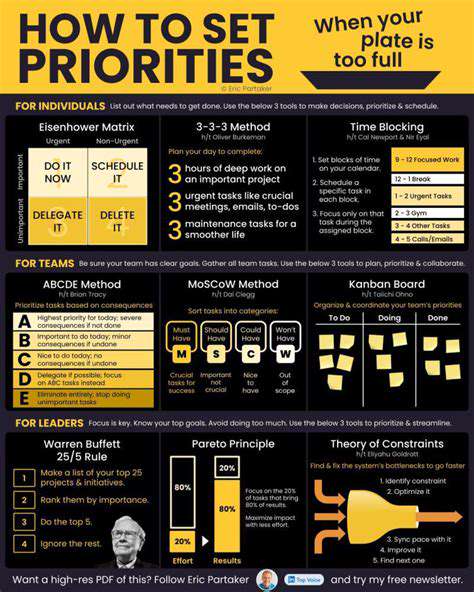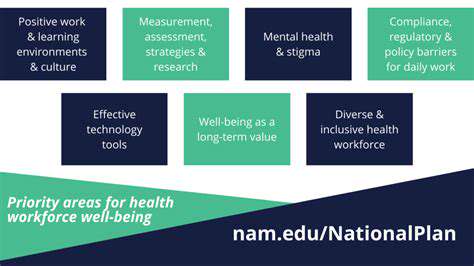Feng Shui for Adult Children's Rooms: Evolving Spaces
Creating a Positive and Productive Environment
Decluttering for Clarity and Focus
A cluttered space often reflects a cluttered mind. Removing unnecessary items from your adult child's room can significantly impact their ability to focus on tasks, both academic and personal. This doesn't mean stripping the room bare, but rather intentionally curating the items that promote a sense of calm and order. Consider donating or discarding items that are no longer needed or used, creating designated spaces for belongings, and implementing a system for maintaining organization. This mindful decluttering process can foster a sense of control and accomplishment, which positively influences their overall well-being.
Implementing a consistent storage system is key. Labeling containers and shelves clearly ensures easy access and reduces the frustration of searching for misplaced items. This simple act of organization contributes to a smoother daily routine and minimizes stress. A well-organized space promotes efficiency and allows your child to focus on their personal growth and academic pursuits without the distractions of a disorganized environment.
Color Psychology for Emotional Well-being
Colors evoke different emotions and can significantly influence mood and energy levels. Consider incorporating calming colors like soft blues, greens, or lavenders into the room's décor. These hues are associated with peace and tranquility, promoting a sense of calm and relaxation. Avoid overly stimulating colors like bright reds or oranges in large quantities, as these can be overwhelming and increase anxiety.
Using a variety of colors in a balanced way can also be beneficial. Introduce pops of vibrant colors through artwork, textiles, or accessories to add a touch of personality and visual interest without disrupting the overall calming atmosphere. This thoughtful approach to color selection can create a space that fosters emotional well-being and encourages a positive and productive environment.
Natural Light and Airflow for Vitality
Natural light is essential for boosting mood and energy levels. Maximize natural light by keeping windows unobstructed and using sheer curtains or blinds to allow sunlight to stream into the room. Natural light is a powerful mood enhancer and can help to regulate circadian rhythms, contributing to better sleep and overall well-being. Open windows to allow fresh air to circulate, promoting a healthier and more invigorating atmosphere.
Proper ventilation is crucial for a healthy environment. Ensure adequate airflow by opening windows regularly and using fans to circulate air. Fresh air can significantly reduce feelings of stagnation and promote a more positive and productive atmosphere. This simple practice can refresh the space and invigorate the mind and body.
Strategic Furniture Placement for Flow
Strategic furniture placement is vital for creating a functional and aesthetically pleasing space. Consider the flow of traffic and ensure that there's adequate space for movement throughout the room. Avoid overcrowding the room with furniture, as this can lead to feelings of claustrophobia and limit productivity. Ensure that desks or study areas are positioned to optimize natural light and minimize distractions.
Incorporating Personal Touches for Inspiration
Allowing your adult child to personalize their space is crucial for fostering a sense of ownership and pride. Encourage them to incorporate elements that reflect their interests and passions, such as artwork, plants, or meaningful items. This helps create a space that feels uniquely theirs, fostering a sense of belonging and inspiration. Displaying photos or mementos that hold personal significance can create a comforting and inspiring ambiance.
Mindful Feng Shui Principles for Harmony
Integrating mindful Feng Shui principles can create a harmonious space that promotes positive energy flow. Ensure that the space is free of clutter and that there are no obstructions to the flow of energy. Consider using mirrors strategically to reflect light and create a sense of spaciousness. Incorporating plants can bring life and vibrancy into the room, enhancing the overall atmosphere. These thoughtful touches can transform the space into a sanctuary where productivity and positivity thrive.


Harnessing the Power of Natural Elements
Harnessing the Energy of Wood
Incorporating natural wood elements, such as furniture made from bamboo or reclaimed wood, can bring a sense of grounding and tranquility to the space. The warm tones and natural textures of wood promote a calming atmosphere, perfect for a young adult seeking a peaceful retreat. Consider a small wooden desk or a bedside table made from sustainable wood to create a focus point in the room, encouraging a sense of order and responsibility.
Using wooden accents, like decorative bowls or trays, can also introduce a touch of nature without overwhelming the space. This subtle incorporation of wood can help to create a harmonious balance between the need for personal expression and the desire for a calming environment.
Cultivating Abundance with Earth Elements
Earthy tones and textures, such as terracotta pots, woven rugs, or natural stone accents, can foster a sense of stability and groundedness. These elements promote a feeling of security and belonging, which can be crucial for adult children navigating independence and establishing their own homes. Consider a woven rug with a natural color palette to anchor the space and provide a sense of warmth and comfort.
Incorporating elements like stone or ceramic sculptures, or even a simple terracotta pot with herbs or plants, can bring the grounding energy of Earth into the room. This creates a sense of stability and encourages a focus on nurturing both physical and mental well-being.
Enhancing Focus with Metal Accents
Strategic use of metal accents, such as sleek metal frames for artwork or decorative metal sculptures, can enhance focus and clarity. These elements can help to channel energy and create a sense of purpose. A metal desk organizer or a framed mirror with a metal frame can add a touch of sophistication and encourage productivity and organization. This helps to create a space that supports their goals and ambitions.
Promoting Harmony with Water Elements
Introduce flowing water elements, such as a small fountain or a decorative water feature, to promote harmony and tranquility. The gentle sound of flowing water can create a soothing ambiance and aid in reducing stress. A small, tabletop fountain can add a touch of serenity to the room without overwhelming the space, encouraging relaxation and a sense of peace.
Balancing Energy with Fire Elements
Strategic use of fire elements, such as warm lighting or a decorative fireplace (if appropriate for the space and building), can stimulate creativity and passion. These elements can help to encourage a sense of enthusiasm and drive. Warm lighting, such as a warm-toned lamp or pendant light, can create a cozy and inviting atmosphere, while promoting a sense of warmth and comfort.
Encouraging Growth with Fire Elements
Combining natural elements is key to creating a Feng Shui-inspired space that supports growth and development. A thoughtfully curated collection of plants, natural light, and calming colors can help promote a sense of well-being. These elements work in synergy to nurture a sense of personal growth and encourage creativity.
Maintaining Balance with Air Elements
Incorporating elements that represent the air element, such as strategically placed mirrors or decorative wind chimes, can promote clear communication and facilitate the flow of positive energy. Mirrors can help to visually expand the space and create a sense of openness, while wind chimes can add a calming, gentle sound. These elements can help to foster clarity of thought and encourage open communication within the space.











